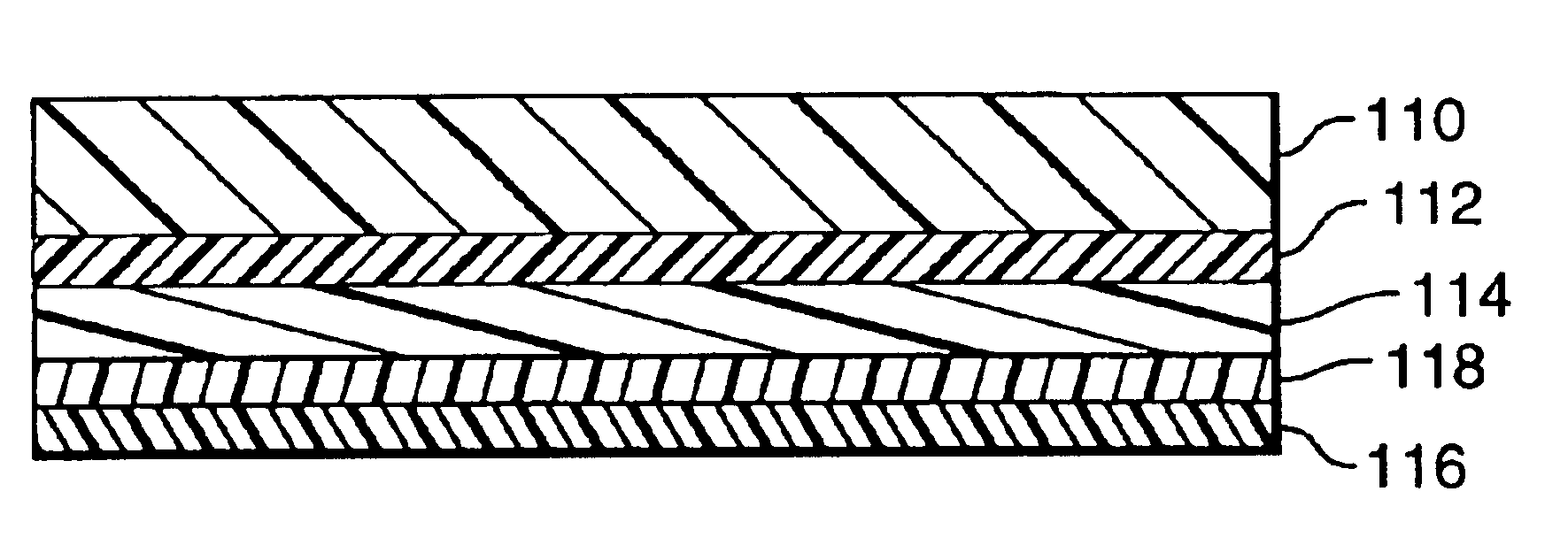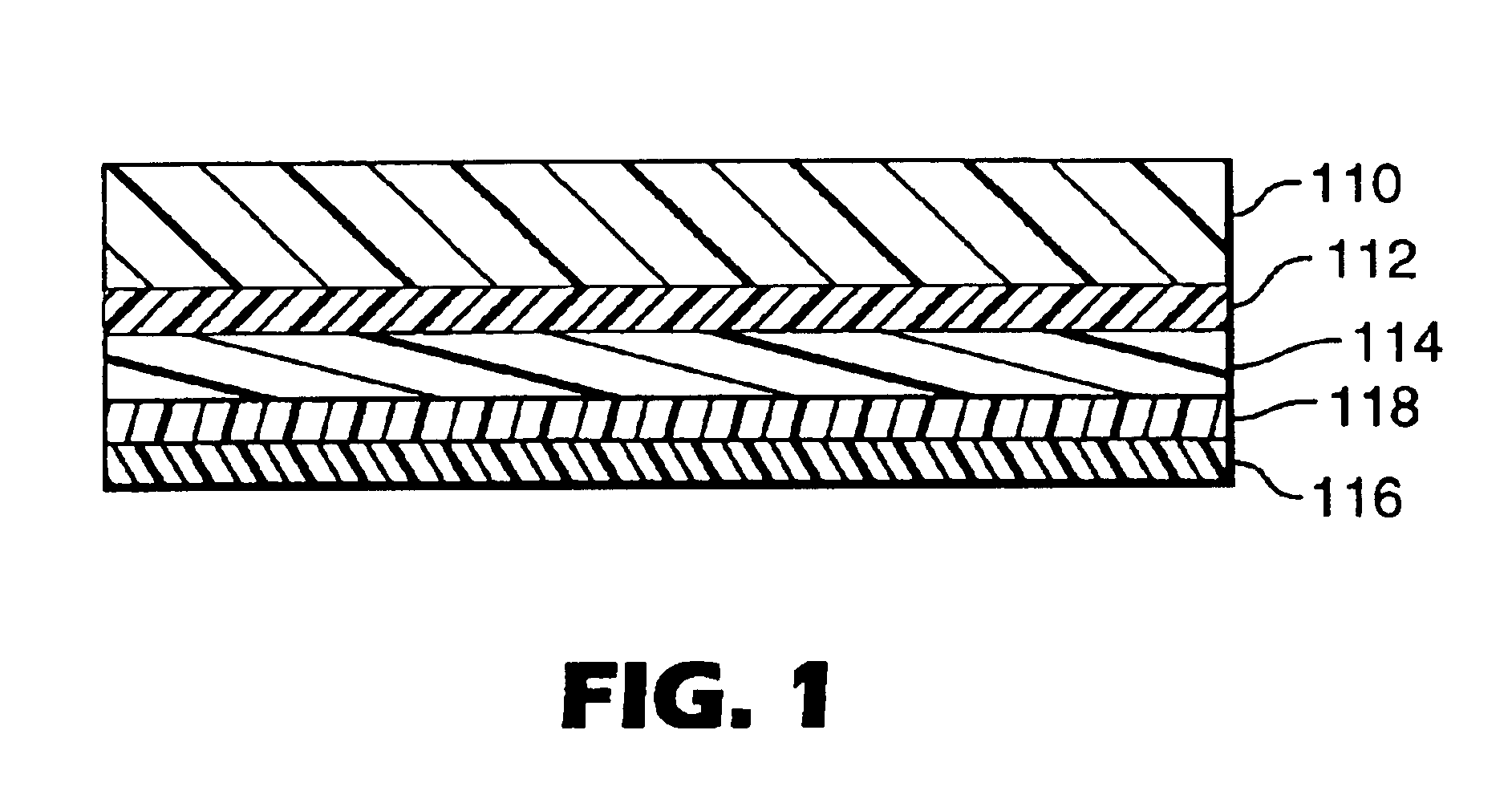Selective thermal transfer of light emitting polymer blends
a technology of light-emitting polymer and blend, which is applied in the direction of thermal imaging, natural mineral layered products, printing, etc., can solve the problems of difficult selective thermal transfer of high-fidelity leps, and difficult to achieve high-fidelity selective thermal transfer of leps. , the effect of improving thermal transfer fidelity
- Summary
- Abstract
- Description
- Claims
- Application Information
AI Technical Summary
Benefits of technology
Problems solved by technology
Method used
Image
Examples
example 1
Preparation of a Receptor with a PEDT / PSS Buffer Layer
A receptor substrate having a PEDT / PSS buffer layer was prepared in the following manner.
An indium tin oxide (ITO) striped substrate was spin coated at 2000 r.p.m. with a buffer solution consisting of poly(3,4-ethylenedioxythiophene) / poly(styrene sulfonicacid) (PEDT / PSS) in de-ionized water (99.5:0.5 water to PEDT / PSS, by weight). The PEDT / PSS buffer material was the PEDT / PSS commercially available from Bayer Corporation under the trade designation Baytron P 4083. The PEDT / PSS coated substrate was heated at 110° C. on a hot plate for 5 minutes in air. The PEDT / PSS coating serves as a hole injecting buffer layer in OLEDs.
example 2
Preparation of a Receptor with an Active Primer Layer
A receptor substrate having an active primer layer was prepared in the following manner.
An indium tin oxide (ITO) striped substrate was spin coated at 2000 r.p.m. with a buffer solution consisting of PEDT / PSS in de-ionized water (70:30 water to PEDT / PSS, by weight). The PEDT / PSS coated substrate was heated at 110° C. on a hot plate for 5 minutes in air. The PEDT / PSS coating served as a hole injecting buffer layer in the patterned OLEDs (see Example 7). An active primer layer was then coated over the PEDT / PSS coating. The active primer layer was a 1:1 dispersion of bis(3-methylphenyl)N,N′ dimethylbenzidine (TPD) in polystyrene (50,000 MW, available from Polysciences). The TPD was obtained from Aldrich Chemical Company, Milwaukee, Wis. The polystyrene used had a 50,000 molecular weight and was obtained from Polysciences, Warrington, Pa. The active primer was spin coated onto the PEDT / PSS layer out of a 1.5% weight-to-volume toluene ...
example 4
Preparation of a Donor Sheet with a PPV / Polystyrene Blend Transfer Layer
A thermal transfer donor sheet having a light emitting polymer blend transfer layer was prepared in the following manner.
An LTHC solution was coated onto a 0.1 mm thick PET film substrate as in Example 3. Next, an interlayer was coated onto the cured LTHC layer as in Example 3. Next, a 1:1 by weight blend of a PPV light emitting polymer and polystyrene was spin coated out of a 0.5% weight-to-volume toluene solution onto the cured interlayer. The PPV was one commercially available from Covion Organic Semiconductors GmbH, Frankfurt, Germany, and identified as COVION PDY 132. The polystyrene used had a 50,000 molecular weight and was obtained from Polysciences, Warrington, Pa.
PUM
| Property | Measurement | Unit |
|---|---|---|
| thick | aaaaa | aaaaa |
| thick | aaaaa | aaaaa |
| thickness | aaaaa | aaaaa |
Abstract
Description
Claims
Application Information
 Login to View More
Login to View More - R&D
- Intellectual Property
- Life Sciences
- Materials
- Tech Scout
- Unparalleled Data Quality
- Higher Quality Content
- 60% Fewer Hallucinations
Browse by: Latest US Patents, China's latest patents, Technical Efficacy Thesaurus, Application Domain, Technology Topic, Popular Technical Reports.
© 2025 PatSnap. All rights reserved.Legal|Privacy policy|Modern Slavery Act Transparency Statement|Sitemap|About US| Contact US: help@patsnap.com


